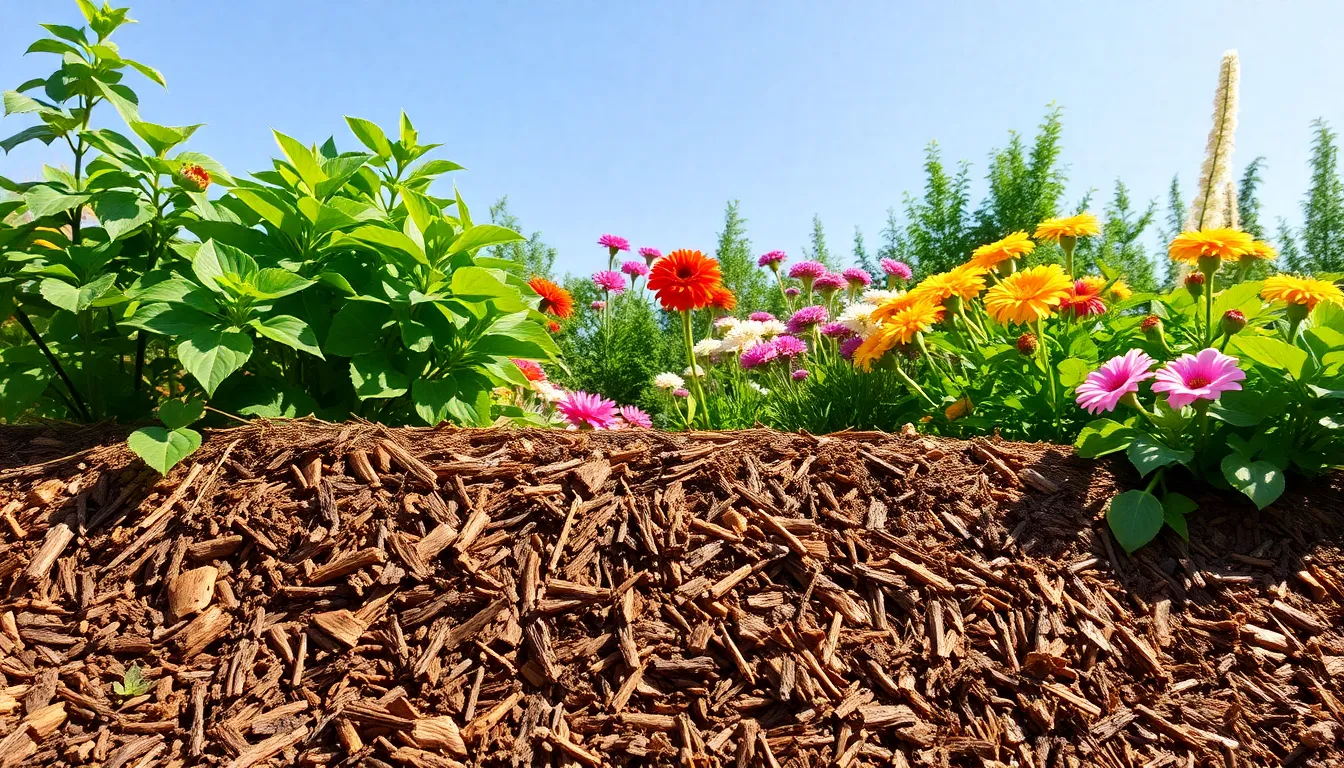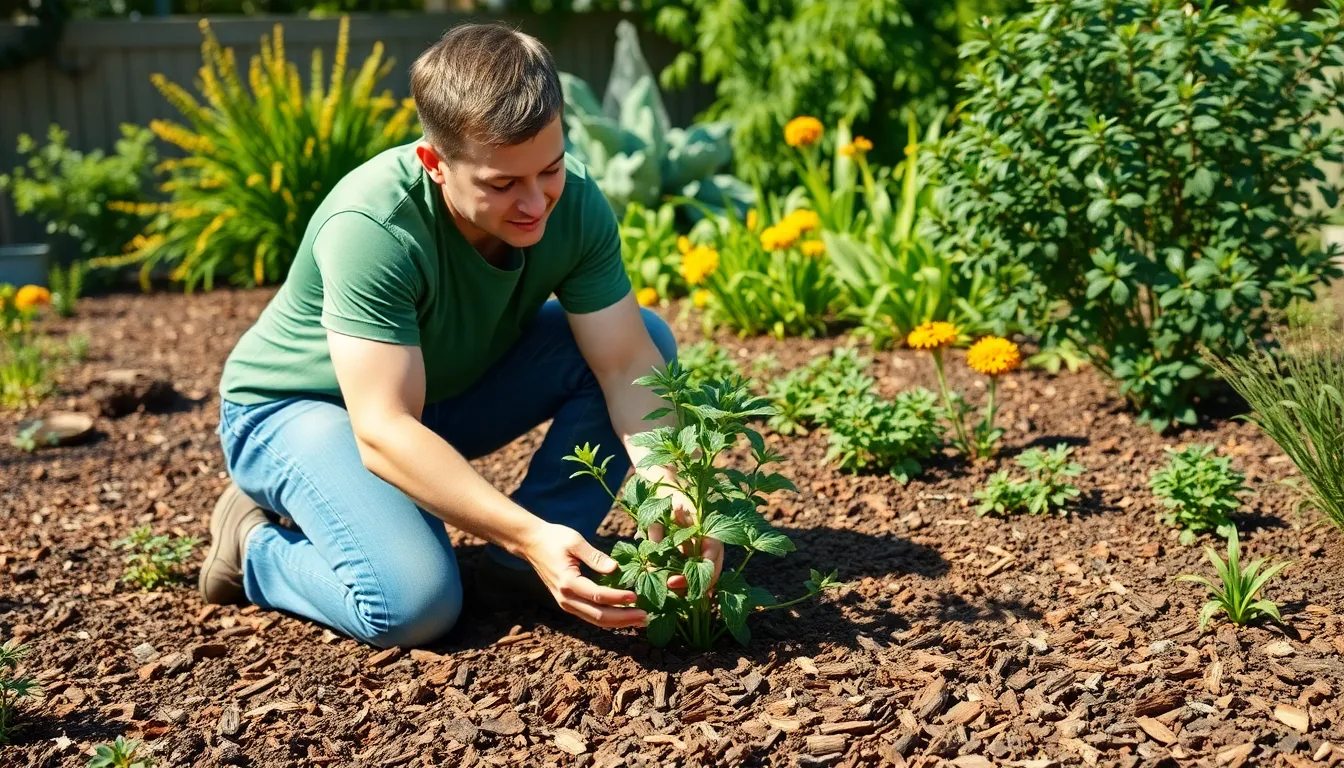Mulching techniques might not sound like the hottest topic at the garden party, but they’re the secret sauce to a thriving landscape. Imagine your garden as a luxurious spa day—mulch is the soothing robe that keeps the soil cozy and happy. With the right techniques, it can help retain moisture, suppress those pesky weeds, and even give your plants a much-needed nutrient boost.
Table of Contents
ToggleOverview Of Mulching Techniques
Mulching techniques enhance soil health and garden aesthetics through various methods. Organic mulch includes materials like wood chips, straw, and shredded leaves. These substances decompose, enriching the soil with nutrients.
In contrast, inorganic mulch encompasses gravel, plastic sheeting, and rubber products. These options maintain moisture but do not add nutrients. Depending on the desired effect, gardeners choose the right type of mulch for their needs.
Applying mulch benefits gardens significantly. It retains moisture, reducing the need for frequent watering. Weeds struggle to grow through a thick layer of mulch, leading to less competition for nutrients.
Some gardeners prefer deep mulching while others opt for shallow layers. Deep mulching involves applying a thicker layer, typically around four inches. This strategy maximizes moisture retention and improves the soil’s organic matter over time.
Shallow mulching offers easier access to soil and plant roots. Applying two inches of thin mulch creates a balance between soil contact and moisture retention.
Regular maintenance is crucial for effectiveness. Mulch breaks down over time, so replenishing is necessary to maintain its benefits. Identifying the right timing for reapplication ensures optimal performance of mulch layers.
By understanding various mulching techniques, gardeners can tailor their approaches to suit specific plants and environments effectively. Each method presents unique advantages that contribute to healthier gardens.
Benefits Of Mulching

Mulching provides a variety of benefits that significantly enhance gardening success.
Soil Moisture Retention
Mulch acts as a barrier, significantly reducing evaporation from the soil surface. It helps maintain consistent moisture levels, which is crucial for plant health. Organic mulches, like wood chips or straw, break down over time and improve soil structure, further aiding water retention. Studies show that gardens with mulch retain up to 50% more moisture than bare soil. This boost in moisture means plants can access water more easily during dry spells. Properly applied mulch prevents water runoff, allowing it to permeate the soil deeply.
Weed Control
Weed growth diminishes significantly with the application of mulch. A thick layer of mulch obstructs sunlight, which inhibits weed seed germination. Organic types reinforce this effect by decomposing slowly, providing added nutrients while suppressing weeds. On average, mulching can reduce weed presence by up to 90%. Less competition from weeds means plants can thrive better without added stress. Regular maintenance of mulch layers is essential for ongoing weed control.
Temperature Regulation
Mulch serves as an insulator for soil temperature, keeping it stable year-round. In summer, it shields the soil from intense heat, preventing overheating. Conversely, during winter, mulch conserves warmth, protecting plant roots from extreme cold. This temperature stabilization supports healthy root development, which is essential for overall plant vigor. Various studies indicate that mulched soils experience temperature fluctuations that are less extreme than unmulched soils. Temperature regulation benefits different plants, contributing to a robust garden ecosystem.
Different Types Of Mulching Techniques
Mulching techniques vary significantly, with two main categories: organic and inorganic mulches. Each type serves unique purposes in gardening.
Organic Mulching
Organic mulches consist of naturally occurring materials. Wood chips, straw, and shredded leaves enrich the soil as they decompose, enhancing nutrient levels. These materials also contribute to soil structure, improving aeration and water retention. Mulching with organic materials suppresses weeds effectively, as they block sunlight from reaching the soil surface. Gardeners appreciate organic mulches for their sustainability, as they promote a healthy ecosystem and attract beneficial organisms. Maintaining organic mulch involves regular replenishment, typically every season, to ensure its effectiveness.
Inorganic Mulching
Inorganic mulches include materials such as gravel, stones, and plastic. These options effectively retain moisture while providing aesthetic appeal. Unlike organic mulches, inorganic varieties do not decompose, requiring less frequent replacement. Gravel and stones create a barrier that controls weeds and minimizes evaporation. Plastic mulch, in particular, helps regulate soil temperature and encourages faster growth in certain crops. However, care is necessary to monitor moisture levels, as inorganic mulches can sometimes hinder water penetration.
How To Choose The Right Mulching Technique
Choosing the right mulching technique depends on various factors. Gardeners should consider both plant types and climate conditions before deciding on a method.
Considerations For Plant Types
Different plants respond uniquely to mulch. For instance, delicate seedlings benefit from light, airy mulches that prevent rot while still allowing moisture penetration. Substantial plants, like shrubs and perennials, thrive with thicker, organic layers that enhance soil health over time. Fruiting vegetables may require careful monitoring of moisture levels, necessitating a balance between mulch thickness and watering needs. Assessing the specific requirements of each plant helps in selecting the most efficient mulch type.
Climate Factors
Climate impacts mulching effectiveness. Warm climates often necessitate materials that conserve moisture and regulate soil temperature, such as wood chips or straw. In contrast, regions with heavy rainfall might benefit from gravel, which aids in drainage while preventing erosion. Seasonal temperature variations also dictate choices; for instance, mulching in winter can protect root systems from freeze damage. Understanding local climate patterns enables gardeners to select a mulching strategy that promotes plant health throughout the seasons.
Mulching techniques play a vital role in creating a healthy and thriving garden. By selecting the right type of mulch and applying it effectively, gardeners can enhance soil health while reducing maintenance efforts. The choice between organic and inorganic mulches allows for tailored solutions that meet specific plant and climate needs. Regular upkeep ensures that the benefits of mulching are sustained over time, promoting moisture retention and weed control. With the right approach, mulching can transform any garden into a flourishing oasis, making it an essential practice for both novice and experienced gardeners alike.




